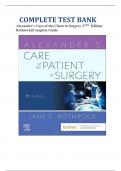COMPLETE TEST BANK
Alexander’s Care of the Client in Surgery 17TH Edition
Rothrock||Complete Guide
,Table of Contents
Unit 1: Foundations for Practice
1. Concepts Basic to Perioperative Nursing
2. Client Safety and Risk Management
3. Workplace Issues and Staff Safety
4. Infection Prevention and Control
5. Anesthesia
6. Positioning the Client for Surgery
7. Sutures, Sharps, and Instruments
8. Surgical Modalities
9. Wound Healing, Dressings, and Drains
10. Postoperative Client Care and Pain Management
Unit 2: Surgical Interventions
11. Gastrointestinal Surgery
12. Surgery of the Liver, Biliary Tract, Pancreas, and Spleen
13. Hernia Repair
14. Gynecologic and Obstetric Surgery
15. Genitourinary Surgery
16. Thyroid and Parathyroid Surgery
17. Breast Surgery
18. Ophthalmic Surgery
19. Otorhinolarygologic Surgery
20. Orthopedic Surgery
21. Neurosurgery
22. Reconstructive and Aesthetic Plastic Surgery
22. Thoracic Surgery
23. Vascular Surgery
24. Cardiac Surgery
Unit 3: Special Considerations
26. Pediatric Surgery
27. Geriatric Surgery 28. Trauma Surgery
29. Interventional and Image-Guided Procedures
30. Integrative Health Practices: Complementary and Alternative Therapies
,Chapter 01: Concepts Basic to Perioperative Nursing
Rothrock: Alexander’s Care of the Client in Surgery, 17th Edition
MULTIPLE RESPONSES
1. The Perioperative Client Focused Model presents key components of nursing influence that guide client
care. Select thestatement that best describes the dynamic relationship within the model.
The client experience and the nursing presence are in continuous interaction.
Structure, process, and outcome are the foundation domains of the model.
The perioperative caregiver is the central dynamic core of the model.
The interrelated nursing process rings bind the client to the model.
ANS
WER
:A
EXPLANATION:The Perioperative Client Focused Model consists of domains or areas of nursing concern:
nursing diagnoses, nursing interventions, and client outcomes. These domains are in continuous interaction with
the health system that encircles the focus ofperioperative nursing practice—the client.
2. The Association of PeriOperative Registered Caregivers’ (AORN) Standards of Perioperative Nursing
describes nursing interactions, interventions, and activities with clients. This is based on which standards
category?
Evidence-based
Process
Outcome
Structural
ANS
WER
:B
EXPLANATION:Process standards relate to nursing activities, interventions, and interactions. They are used to
explicate clinical, professional, andquality objectives in perioperative nursing.
3. Which order best describes the process used to implement evidence-based professional nursing?
Literature search, theory review, data analysis, policy development
Regional survey, literature search, meta-analysis, practice change
Identify problem, scientific evidence, develop policy, evaluate outcome
Identify issue, analyze scientific evidence, implement change, evaluate process
ANSWER: D
Evidence-based practice is a systematic, thorough process by which to identify an issue, to collect and evaluate the
best evidence todesign and implement a practice change, and to evaluate the process.
4. The ambulatory surgery unit is planning to develop a standardized skin preparation practice for their unit.
The best process togather scientific information is to:
conduct a survey of skin prep policies at the next AORN chapter meeting.
review their surgical site infection data from the last 6 months.
conduct a literature search on antimicrobial agents and infection prevention.
review the scientific literature from the leading manufacturers of prep solutions.
ANSWER: C
EXPLANATION: Perioperative caregivers have an ethical responsibility to review practices and to modify
them based on the best available scientific evidence. Using research to guide practice is called evidence-
based practice (EBP).
, 5. The cardiac team is developing a standardized sterile back table setup and is unable to find sufficient research
evidence for their project. Where might they look for information on best practices?
Survey regional surgical technology programs for their back table models
Review case studies and expert opinions on sterile back table setups
Review AORN’s Guidelines for Perioperative Practice
on sterilization and disinfection
Consult with facility instrument vendor representatives for their advice
ANS
WER
:B
EXPLANATION: When there is not enough evidence to guide practice, perioperative caregivers should
consider gathering information from variedtrusted sources that reflect best practices.
6. How do institutional standards of care, such as policies and procedures, differ from national standards, such as
AORN’s Standardsof Perioperative Nursing?
They are written by caregivers.
They are written specifically to address
responsibilities under specificcircumstances.
They are collaborative and collective agreement statements.
They are rarely based on research.
ANSWER: B
EXPLANATION: Institutional standards apply to the system or facility that develops them and can be
directive about specific actions in specificcircumstances; national standards provide generalized
authoritative statements that can be implemented in all settings.
7. Which of the following actions best describes an element of the perioperative nursing assessment?
Scanning the surgical schedule for the day before morning report.
Reading the pick/preference list attached to the case cart.
Reviewing the client medical record.
Studying an on-line tutorial about the intended surgical procedure.
ANSWER: C
Assessment is the collection and analysis of relevant health data about the client. Sources of data may be a
preoperative interviewwith the client and the client’s family; review of the planned surgical or invasive
procedure; review of the client’s medical record; examination of the results of diagnostic tests; and consultation
with the surgeon and anesthesia provider, unit caregivers, or other personnel.
8. A frail 76-year-old diabetic woman is scheduled for major surgery. She is vulnerable and at high risk for harm
because of several factors related to her preexisting conditions and overall health status. As part of developing a
plan to guide her care, the caregiver usesstandardized descriptive terms. This step of the nursing process is
called:
nursing diagnosis.
nursing assessment.
nursing outcome.
nursing intervention.
ANSWER: A
EXPLANATION: Nursing diagnosis is the process of identifying and classifying data collected in the
assessment in a way that provides a focus to plan nursing care. Nursing diagnosis components include a
definition of the diagnostic term, defining characteristics and risk factors.
9. During the admission interview, the caregiver initiated the discharge teaching and demonstrated crutch-walking
activities. The teaching activities are what stage of the nursing process?
Assessment




